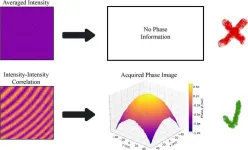(Press-News.org) Every holiday season, Americans buy nearly 30 million live Christmas trees. Many families enjoy not only having a live tree inside their homes but also smelling the fresh fragrance it creates. That smell comes from chemicals called volatile organic compounds (VOCs). However, little is known about how much is emitted and whether they have any health impacts.
“Our nose is a good chemical sensor,” said Dustin Poppendieck, an environmental engineer at the National Institute of Standards and Technology (NIST). “We know that these trees are emitting something, and the question then becomes: How big of a source is it? We wanted to explore which chemicals are emitted and how much, and to put that into the context of other sources of chemicals in a house,” he said.
To answer these questions, Poppendieck and his NIST colleagues took a common type of Christmas tree — a Douglas fir— and sealed it inside a chamber. They then measured the amount and type of VOCs it emitted over 17 days. They also investigated whether the VOCs reacted with other components of indoor air to create new compounds.
The team’s findings have been published in the journal Indoor Environments.
The fresh smell that is commonly associated with Christmas trees comes from a group of VOCs called monoterpenes, which are also found in air fresheners, candles and some personal care products. In the outdoors, conifers, the group of plants that includes most Christmas trees, release monoterpenes, and they can affect outdoor air quality. But little is known about how much monoterpene is released when a tree is cut down and placed indoors.
Studies also show monoterpenes can react with ozone. Ozone in the upper atmosphere serves as a protective barrier against the Sun. At ground level, ozone is created through chemical reactions with light and can cause symptoms such as coughing and throat irritation. Ozone also reacts readily with other chemicals in the air to form new compounds. So, the researchers were interested in seeing the effects of ozone in the presence of an indoor tree.
They placed it inside an environmentally controlled chamber, where they could measure the chemicals emitted from the tree in real time. Using a technique that can detect airborne organic compounds, known as proton-transfer reaction mass spectrometry (PTR-MS), they measured the VOCs emitted over a 17-day period.
In their experiment, the researchers simulated a home environment. They decorated the tree in a typical holiday lighting setup and shone bright lights on it to mimic the day-night cycle. They turned off the lights every 12 hours and watered the tree every day. They brought in outside air at a rate typical for households, and constantly measured chemicals in the indoor air.
Monoterpenes were the most abundant VOC emitted from the tree. They peaked during the first day before diminishing significantly by the third day. Their concentration was initially at the same level of a plug-in air freshener or newly constructed house before it quickly dropped by nearly 10 times its original amount, said Poppendieck. The researchers detected 52 distinct types of monoterpenes.
Researchers then injected ozone into the chamber to see how it affected indoor air chemistry. They found that ozone reacted with the monoterpenes, forming byproducts such as formaldehyde, another type of VOC, as well as other reactive chemicals. The monoterpene concentration diminished even more with the introduction of ozone, while formaldehyde levels rose, which showed an impact on indoor air chemistry. However, the amount of formaldehyde created was relatively small at around 1 part per billion. Typical U.S. houses have formaldehyde concentrations ranging from 20 to 30 parts per billion.
For people who are sensitive to VOCs, Christmas trees could be one possible cause for watery eyes and noses, especially when initially brought indoors. In that case, Poppendieck suggests, opening a window near the tree will reduce exposure. In addition, newly cut trees can be left outdoors or in a garage for three days before bringing them into the home as the emission strength naturally decays over time.
“But for most people,” Poppendieck said, “this shouldn’t be a major concern. I’m still going to have a Christmas tree in my house.”
Don’t forget to water your Christmas tree every day. The greatest risk is a dried-out tree, which can become a fire hazard for your home. NIST has safety tips available on our website.
END
Live Christmas trees affect indoor air chemistry, NIST researchers find
2023-12-22
ELSE PRESS RELEASES FROM THIS DATE:
Evolution of tuberculosis – in new light
2023-12-22
Recent research suggests that the emergence of tuberculosis infection in human populations dates back tens of thousands of years earlier than previously known cases in the Middle East. In collaboration with an international research team, Hungarian researchers have edited and published a special issue of the journal Tuberculosis.
In July 2022, the Department of Anthropology of the University of Szeged organised a conference on the paleopathology and evolution of tuberculosis. The ICEPT3 conference was closely linked to the NRDI-best funded research project of György ...
Study reveals the relationship of gut microbiome on children’s brain development and function
2023-12-22
WELLESLEY, MA – Emerging evidence implicates the gut microbiome in cognitive outcomes and neurodevelopmental disorders, but the influence of gut microbial metabolism on typical neurodevelopment has not been explored in detail.
Researchers from Wellesley College, in collaboration with other institutions, have demonstrated that differences in the gut microbiome are associated with overall cognitive function and brain structure in healthy children. This study – published today in Science Advances – is a part of the Environmental Influences ...
Major breakthrough in hypertension diagnosis could save Government billions
2023-12-22
HMRI and University of Newcastle researcher, Professor Murray Cairns, along with his Precision Medicine team have discovered a way of predicting who will respond to blood pressure treatments to lower sodium in the body. Their findings were published this week in Circulation, a prestigious international cardiology journal.
Professor Cairns says, “High blood pressure – or hypertension related disease – kills up to 20 per cent of people. At least 30 per cent of the adult population has it – that’s ...
Predicting Alzheimer’s dementia in oldest of the old
2023-12-22
PITTSBURGH, Dec. 22, 2023 – A new study indicates that severity of amyloid deposition in the brain — not just age — may be key to determining who will benefit from new anti-amyloid therapies to delay the progression of Alzheimer’s disease.
University of Pittsburgh clinicians and scientists report that the accumulation of toxic amyloid beta clumps that signal Alzheimer’s disease pathology accelerates in old age but the baseline amyloid burden and the overall brain health going into this acceleration ...
Ochsner Health honored with Vizient Southern States Brilliance Award
2023-12-22
NEW ORLEANS, La. – Vizient Southern States, a membership alliance for not-for-profit health care providers, awarded Jason Hill, MD, MMM, clinical innovation officer, Ochsner Health, the 2023 Brilliance Award as a result of being selected to present at the 2023 Connections Summit.
This year, six Vizient Southern States’ members were selected to share their stories of success with a national audience of Vizient members. Selected abstracts showcased their organization’s projects that demonstrated ...
Hubble sights a galaxy with ‘forbidden’ light
2023-12-22
This whirling image features a bright spiral galaxy known as MCG-01-24-014, which is located about 275 million light-years from Earth. In addition to being a well-defined spiral galaxy, MCG-01-24-014 has an extremely energetic core known as an active galactic nucleus (AGN) and is categorized as a Type-2 Seyfert galaxy. Seyfert galaxies, along with quasars, host one of the most common subclasses of AGN. While the precise categorization of AGNs is nuanced, Seyfert galaxies tend to be relatively nearby and their central AGN does not outshine its host, while quasars are very distant AGNs with incredible luminosities that outshine ...
Images hidden in noise revealed by a quantum-inspired method
2023-12-22
Researchers at the University of Warsaw's Faculty of Physics with colleagues from Stanford University and Oklahoma State University have introduced a quantum-inspired phase imaging method based on light intensity correlation measurements that is robust to phase noise. The results of the research have been published in the prestigious journal “Science Advances”. The new imaging method can operate even with extremely dim illumination and can prove useful in emerging applications such as in infrared and X-ray interferometric imaging and quantum and matter-wave ...
Engineers develop a vibrating, ingestible capsule that might help treat obesity
2023-12-22
When you eat a large meal, your stomach sends signals to your brain that create a feeling of fullness, which helps you realize it’s time to stop eating. A stomach full of liquid can also send these messages, which is why dieters are often advised to drink a glass of water before eating.
MIT engineers have now come up with a new way to take advantage of that phenomenon, using an ingestible capsule that vibrates within the stomach. These vibrations activate the same stretch receptors that sense when the stomach is distended, creating an illusory sense of fullness.
In animals who were given this ...
Novel ingestible devices developed to create the illusion of satiety
2023-12-22
Obesity interventions, such as gastric bypass surgery, can alter the signaling of the vagal nerve, which plays a crucial role in regulating digestion. In addition to traditional obesity interventions, new weight-management medications, such as Wegovy, are becoming increasingly popular options for patients with obesity since they are non-invasive and require minimal lifestyle modifications. Developing a variety of non-invasive, convenient weight-management options for patients with obesity is essential to help reduce comorbidities such as diabetes, hypertension, cancer ...
The stomach bug that may raise your risk of Alzheimer’s disease
2023-12-22
A common stomach bacteria found in two thirds of the world population may be linked to a higher risk of Alzheimer’s disease, new research suggests.
The study, published in Alzheimer's & Dementia: The Journal of the Alzheimer's Association, investigated whether a clinically apparent Helicobacter pylori (H. pylori) infection increased the risk of Alzheimer's disease in people aged 50 and older. The prevalent infection can trigger indigestion, gastritis, ulcers, and even stomach cancer.
A team of McGill University researchers analyzed health data of over 4 million people in the United Kingdom aged 50 and above between 1988 and 2019. It found ...





